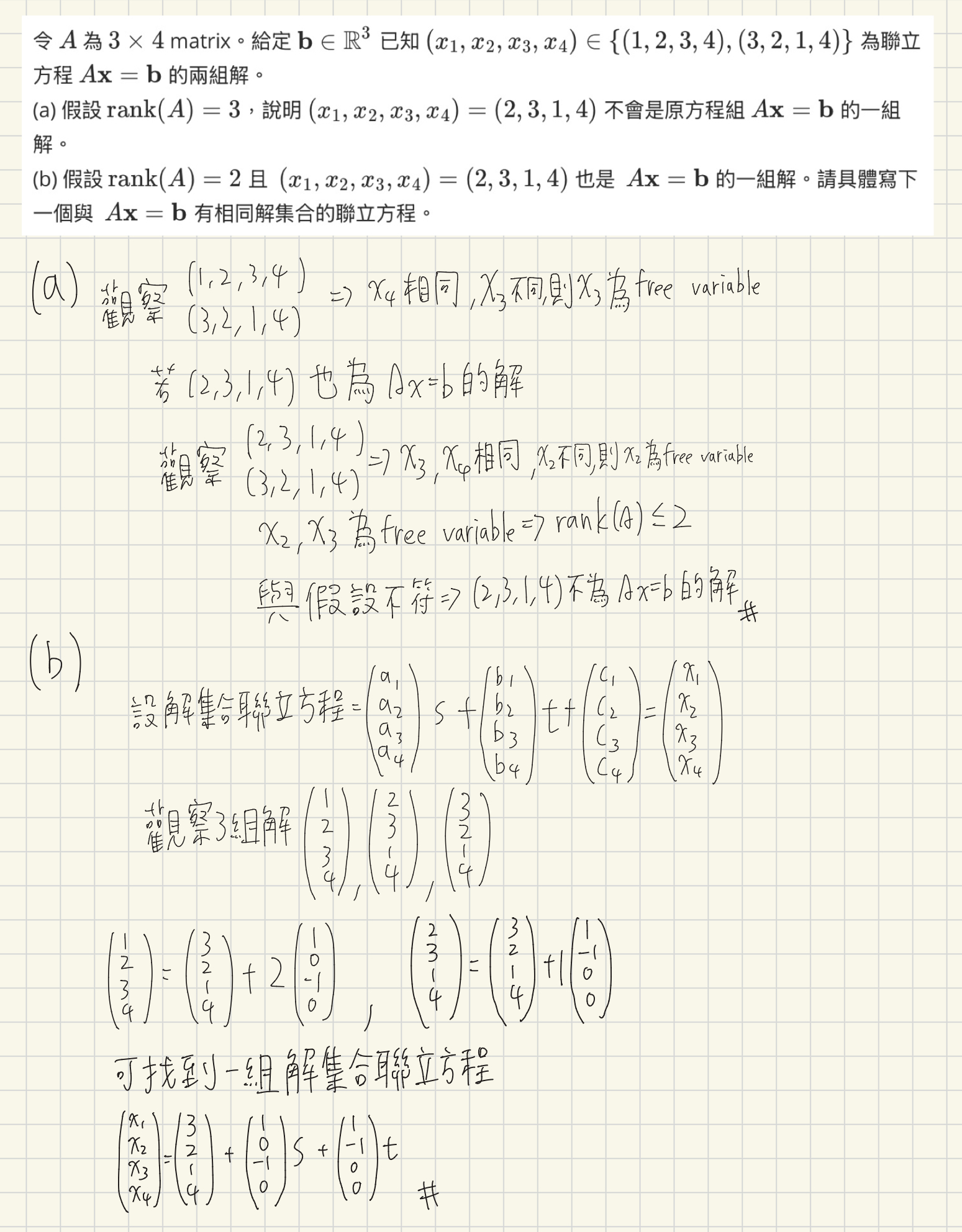討論區
補一個112年的考古題:
令 $A$ 為 $3\times 4$ matrix。給定 $\mathbf{b}\in\mathbb{R}^3$ 已知 $(x_1,x_2,x_3,x_4)\in\{(1,2,3,4),(3,2,1,4)\}$ 為聯立方程 $A\mathbf{x}=\mathbf{b}$ 的兩組解。
(a) 假設 $\mathrm{rank}(A)=3$,說明 $(x_1,x_2,x_3,x_4)=(2,3,1,4)$ 不會是原方程組 $A\mathbf{x}=\mathbf{b}$ 的一組解。
(b) 假設 $\mathrm{rank}(A)=2$ 且 $(x_1,x_2,x_3,x_4)=(2,3,1,4)$ 也是 $A\mathbf{x}=\mathbf{b}$ 的一組解。請具體寫下一個與 $A\mathbf{x}=\mathbf{b}$ 有相同解集合的聯立方程。
解法(?)
解題思路
對於一個 $m\times n$ 的線性方程組 $A\mathbf{x}=\mathbf{b}$,若 $x_k$ 為 pivot variable,則對於任兩組方程組的解,若這兩組解的 $k+1$-th 到 $n$-th 元素都相同,則這兩組解的 $k$-th 元素相同;特別地,如果 $x_n$ 是 pivot variable,則對於任兩組方程組的解,其 $n$-th 元素都相同。我們可以用這個定理來判別一個 variable 是否為 pivot variable。
我們已知兩組解 $\begin{pmatrix}1,2,3,4\end{pmatrix}$, $\begin{pmatrix}3,2,1,4\end{pmatrix}$,可從中得知 $x_3$ 為 free variable。則
- 採 Contrapositive。若 $\begin{pmatrix}2,3,1,4\end{pmatrix}$ 是 $A\mathbf{x}=\mathbf{b}$ 的解,則由定理,與另外一解 $\begin{pmatrix}3,2,1,4\end{pmatrix}$ 比對得知 $x_2$ 為 free variable,則根據定義,$rank(A)\le 2$,則 $rank(A) \not= 3$。
- 若 $rank(A)= 2$ 且 $\begin{pmatrix}2,3,1,4\end{pmatrix}$ 是 $A\mathbf{x}=\mathbf{b}$ 的解。由 (1)(題目中是 a)、$rank(A)=2$ 的前提,和先前的推導可知, $x_1$ 和 $x_4$ 為 pivot variable。確認了每個 pivot variable 的位置,依據解線性方程組的流程,我們可以將所有解表為\[\begin{bmatrix}2\\3\\1\\4\end{bmatrix} + s\begin{bmatrix}u_1\\1\\0\\0\end{bmatrix} + t\begin{bmatrix}v_1\\0\\1\\0\end{bmatrix}\]的形式,從已知的解進行推導。求出解集之後,依據解的形式和求解的流程,反推出一個 有相同解集的 reduced echelon form 的 augmented matrix,並寫成 system of linear equations 的形式。這樣,題目就完成了。
解答
留下答案給各位點評
(a)
Since $\begin{pmatrix}1,2,3,4\end{pmatrix}$ and $\begin{pmatrix}3,2,1,4\end{pmatrix}$ are solutions of $A\mathbf{x}=\mathbf{b}$ and their $4$-th entries are equal but their $3$-rd ones are not, $x_3$ is a free variable.
Assume that $\begin{pmatrix}2,3,1,4\end{pmatrix}$ is a solution of $A\mathbf{x}=\mathbf{b}$. Claim that $rank(A)\not=3$
Since $\begin{pmatrix}2,3,1,4\end{pmatrix}$ and $\begin{pmatrix}3,2,1,4\end{pmatrix}$ are solutions of $A\mathbf{x}=\mathbf{b}$ and their $3$-$4$-th entries are equal but their $2$-nd ones are not, $x_2$ is a free variable.
Then the number of pivot variables will not be more than $2$ i.e. by definition, $rank(A)\le 2$. Then $rank(A)\not=3$.$\blacksquare$
(b)
Assume that $rank(A)=2$ and $\begin{pmatrix}2,3,1,4\end{pmatrix}$ is a solution of $A\mathbf{x}=\mathbf{b}$.
With the assumption and (a), it’s trivial that the pivot variables of $A$ are $x_1$, $x_4$.
Note that \[\begin{bmatrix}2\\3\\1\\4\end{bmatrix} = \begin{bmatrix}2\\3\\1\\4\end{bmatrix} + 0\begin{bmatrix}-1\\1\\0\\0\end{bmatrix} + 0\begin{bmatrix}-1\\0\\1\\0\end{bmatrix}\]\[\begin{bmatrix}3\\2\\1\\4\end{bmatrix} = \begin{bmatrix}2\\3\\1\\4\end{bmatrix} + (-1)\begin{bmatrix}-1\\1\\0\\0\end{bmatrix} + 0\begin{bmatrix}-1\\0\\1\\0\end{bmatrix}\]\[\begin{bmatrix}1\\2\\3\\4\end{bmatrix} = \begin{bmatrix}2\\3\\1\\4\end{bmatrix} + (-1)\begin{bmatrix}-1\\1\\0\\0\end{bmatrix} + 2\begin{bmatrix}-1\\0\\1\\0\end{bmatrix}.\]
Thus, since the number of free variables is $2$, we can describe the solutions of the $A\mathbf{x}=\mathbf{b}$ in the following form: \[\mathbf{x} = \begin{bmatrix}2\\3\\1\\4\end{bmatrix} + s\begin{bmatrix}-1\\1\\0\\0\end{bmatrix} + t\begin{bmatrix}-1\\0\\1\\0\end{bmatrix}, s,t\in\mathbb{R}\].
Also, note that the solutions of the system \[\begin{cases}&x_1+&x_2+&x_3&=6\\&x_4&&&=4\end{cases}\] are also the form above since it’s obvious $\begin{bmatrix}2\\3\\1\\4\end{bmatrix}$ and $\begin{bmatrix}-1\\1\\0\\0\end{bmatrix}$ and $\begin{bmatrix}-1\\0\\1\\0\end{bmatrix}$ are the solutions of the system and the rank of the coefficient matrix of the system is also $2$.
Then we found a system $\begin{cases}&x_1+&x_2+&x_3&&=6\\&&&&x_4&=4\end{cases}$ which has the same solution set as the one of $A\mathbf{x}=\mathbf{b}$. $\blacksquare$
補充
對於 (b) 小題中,如何推出解集,以及如何舉出一個有相同解集的 reduced echelon form 的 system,這兩個步驟我還沒想出很好的方法、描述和寫法,注意得到,但我不好描述。
期待大家的補充。
為何知道解集合的形式?
看到大家的解釋都依直覺把解集合寫出來?為何寫出的解會是方程組的解?為何寫出的解就是所有的解?這些是要有了向量空間的維度概念才能解釋。沒有具體的方程組目前是無法將解集合寫下來的。這個問題的重點是即使沒有具體的方程組但知道 pivot 位置,就能寫下 reduced echelon form 的形式,再利用幾個已知解將此 reduced echelon form 決定出來。
這是講義 Week02 中 Theorem 1.3.7 證明的基本精神。在學習過程了解各個定理的基本想法比起看懂證明重要得多。Exercise 1.8 也是類似的問題。請大家習慣用 reduced echelon form 處理,才算了結它的重要性。
補充 (b) 小題的解法
法 1
解題思路
我們希望求出原 coefficient matrix 的 reduced echelon form 後,再進一步代入已知解,得出與原方程組有相同解集合的聯立方程組。
注意到根據假設,我們可以用已知的三組解,給出原方程組的 homogeneous system 的至少兩組非零解。最重要的是,這兩組解給出的資訊可以充分的將所有 free variables 的 column 表為 pivot variables 的 column 的線性組合,而我們已經知道所有 pivot variables 的位置。
由於我們考慮的是 reduced echelon form,根據定義,其 pivot variables 的 column 已經確定,因此 reduced echelon form 也被確定,也就找得到與原方程組有相同解集合的聯立方程組。
這個思路預設如果兩線性方程組的 homogeneous system 的解集合相同且兩線性方程組存在共同解,則該兩組線性方程組的解集合相同。
(b) 小題解答
Lemma. If two systems of linear equations $A\mathbf{x}=\mathbf{b}$ and $C\mathbf{x}=\mathbf{d}$ has at least one mutual solution and $\{\mathbf{x}\mid A\mathbf{x}=\mathbf{0}\} = \{\mathbf{x}\mid C\mathbf{x}=\mathbf{0}\}$, then $\{\mathbf{x}\mid A\mathbf{x}=\mathbf{b}\} = \{\mathbf{x}\mid C\mathbf{x}=\mathbf{d}\}$.
(We omit the proof here.)
Assume that $rank(A)=2$ and $\begin{bmatrix}2\\3\\1\\4\end{bmatrix}$ is a solution of $A\mathbf{x}=\mathbf{b}$.
With the assumption and (a), it’s trivial that the pivot variables of $A$ are $x_1$, $x_4$.
Let $C = [c_{ij}]_{\begin{aligned}1\le i\le 3\\1\le j\le 4\end{aligned}}$ be the reduced echelon form of $A$.
Since $\begin{bmatrix}1\\2\\3\\4\end{bmatrix}$, $\begin{bmatrix}3\\2\\1\\4\end{bmatrix}$ and $\begin{bmatrix}2\\3\\1\\4\end{bmatrix}$ satisfy $A\mathbf{x}=\mathbf{b}$, $A(\begin{bmatrix}1\\2\\3\\4\end{bmatrix} - \begin{bmatrix}3\\2\\1\\4\end{bmatrix}) = A\begin{bmatrix}-2\\0\\2\\0\end{bmatrix} = \mathbf{0}$ and $A(\begin{bmatrix}1\\2\\3\\4\end{bmatrix} - \begin{bmatrix}2\\3\\1\\4\end{bmatrix}) = \begin{bmatrix}-1\\-1\\2\\0\end{bmatrix} = \mathbf{0}$.
Thus $\begin{bmatrix}-2\\0\\2\\0\end{bmatrix}$ and $\begin{bmatrix}-1\\-1\\2\\0\end{bmatrix}$ are solutions to $A\mathbf{x}=\mathbf{0}$.
Since $C$ is the reduced echelon form of $A$, $\begin{bmatrix}-2\\0\\2\\0\end{bmatrix}$ and $\begin{bmatrix}-1\\-1\\2\\0\end{bmatrix}$ are also solutions to $C\mathbf{x}=\mathbf{0}$ and
- $C\begin{bmatrix}-2\\0\\2\\0\end{bmatrix} = -2\mathbf{c}_1 + 2\mathbf{c}_3 = \mathbf{0}$.
- $C\begin{bmatrix}-1\\-1\\2\\0\end{bmatrix} = -1\mathbf{c}_1 + -1\mathbf{c}_2 + 2\mathbf{c}_3 = \mathbf{0}$.
Since $C$ is reduced echelon form of $A$, the pivot variables of $C$ are $x_1$, $x_4$, and by definition, \[\mathbf{c}_1 = \begin{bmatrix}1\\0\\0\end{bmatrix}, \mathbf{c}_4 = \begin{bmatrix}0\\1\\0\end{bmatrix}.\]
Thus, $\mathbf{c}_3 = \begin{bmatrix}1\\0\\0\end{bmatrix}$, $\mathbf{c}_2 = \begin{bmatrix}1\\0\\0\end{bmatrix}$ and \[C = \begin{bmatrix}1&1&1&0\\0&0&0&1\\0&0&0&0\end{bmatrix}.\]
Since $C\begin{bmatrix}1\\2\\3\\4\end{bmatrix} = \begin{bmatrix}6\\4\\0\end{bmatrix}$ and $A\begin{bmatrix}1\\2\\3\\4\end{bmatrix}=\mathbf{b}$ and $\{\mathbf{x}\mid C\mathbf{x}=\mathbf{0}\} = \{\mathbf{x}\mid A\mathbf{x}=\mathbf{0}\}$, by the Lemma, the system $\begin{bmatrix}1&1&1&0\\0&0&0&1\\0&0&0&0\end{bmatrix}\mathbf{x} = \begin{bmatrix}6\\4\\0\end{bmatrix}$ and $A\mathbf{x}=\mathbf{0}$ have same solution sets and we're done.$\blacksquare$
註:我引用的這個 Lemma 似乎上課有教過。
法 2
解題思路
我們希望求出原方程組的 augmented matrix 的 reduced echelon form。
由於我們考慮的是 reduced echelon form,且已知 pivot variables 的位置,根據定義,其 pivot variables 的 column 已經確定。將三個已知解代入,會得到一個決定 column 的聯立方程組。解開方程組便結束了。
(b) 小題解答
Assume that $rank(A)=2$ and $\begin{bmatrix}2\\3\\1\\4\end{bmatrix}$ is a solution of $A\mathbf{x}=\mathbf{b}$.
With the assumption and (a), it’s trivial that the pivot variables of $A$ are $x_1$, $x_4$.
Let $[C\mid\mathbf{d}]$ be the reduced echelon form of $[A\mid\mathbf{b}]$. Then
Since $[C\mid\mathbf{d}]$ is reduced echelon form of $[A\mid\mathbf{b}]$, the pivot variables of $C$ are $x_1$, $x_4$, and by definition, \[\mathbf{c}_1 = \begin{bmatrix}1\\0\\0\end{bmatrix}, \mathbf{c}_4 = \begin{bmatrix}0\\1\\0\end{bmatrix}.\]
Also, since $[C\mid\mathbf{d}]$ is reduced echelon form of $[A\mid\mathbf{b}]$ and $\begin{bmatrix}1\\2\\3\\4\end{bmatrix}$, $\begin{bmatrix}3\\2\\1\\4\end{bmatrix}$ and $\begin{bmatrix}2\\3\\1\\4\end{bmatrix}$ are solutions to $A\mathbf{x}=\mathbf{b}$, $\begin{bmatrix}1\\2\\3\\4\end{bmatrix}$, $\begin{bmatrix}3\\2\\1\\4\end{bmatrix}$ and $\begin{bmatrix}2\\3\\1\\4\end{bmatrix}$ are solutions to $C\mathbf{x}=\mathbf{d}$ and \[\begin{aligned}&\begin{cases}&1\begin{bmatrix}1\\0\\0\end{bmatrix} + &2\mathbf{c}_2 + &3\mathbf{c}_3 + &4\begin{bmatrix}0\\1\\0\end{bmatrix} &= \mathbf{d} \\&3\begin{bmatrix}1\\0\\0\end{bmatrix} + &2\mathbf{c}_2 + &1\mathbf{c}_3 + &4\begin{bmatrix}0\\1\\0\end{bmatrix} &= \mathbf{d} \\&2\begin{bmatrix}1\\0\\0\end{bmatrix} + &3\mathbf{c}_2 + &1\mathbf{c}_3 + &4\begin{bmatrix}0\\1\\0\end{bmatrix} &= \mathbf{d} \\\end{cases} \\\Rightarrow&\begin{cases}\mathbf{c}_2 &= \begin{bmatrix}1\\0\\0\end{bmatrix}\\\mathbf{c}_3 &= \begin{bmatrix}1\\0\\0\end{bmatrix}\\\mathbf{d} &= \begin{bmatrix}6\\4\\0\end{bmatrix}\\\end{cases}\end{aligned}\]
Thus $[C\mid\mathbf{d}] = \left[\begin{array}{cccc|c}1&1&1&0&6\\0&0&0&1&4\\0&0&0&0&0\end{array}\right]$ and $\begin{bmatrix}1&1&1&0\\0&0&0&1\\0&0&0&0\end{bmatrix}\mathbf{x} = \begin{bmatrix}6\\4\\0\end{bmatrix}$ is the system we want. $\blacksquare$
小總結 (?)
中間關於 column 的聯立方程組,一樣可以使用加減消去法和代入消去法來化簡,似乎也可以用我們所學到的方式來求解,雖然這種形式目前看起來很怪🫠。
以及,藉由 reduced echelon form 的性質寫下 pivot 的 column 這部分,個人覺得比較不直覺一些,小心寫錯。
這兩種方式都是運用 reduced echelon form 的性質得知 pivot 的 column,並嘗試將其他的 column 用已知的 column 表示。差異僅在一個是在 homogeneous 的模式底下完成,一個是直接動刀。
不知道各位覺得哪一種方法比較好,還是我應該照已知條件寫出 reduced echelon form 的每一個 entry、然後設未知數一個一個解。
修改紀錄
- 將 法1-解題思路 的「給出兩個原方程組的 homogeneous system 的至少兩組非零解」改成「給出原方程組的 homogeneous system 的至少兩組非零解」。
- 將 法2-解題思路 的 「同時,因為 reduced echelon form 唯一,我們只要找到一組解就可以了。」刪除。
- 在 法2-(b)_小題解答 的解方程組的過程中補上 $\Rightarrow$。
重新整理解法和思路
解題思路
我們可以用 Lemma 1.3.2 來判別一個 variable 是否為 pivot variable。
運用 Lemma 1.3.2,從題目給的兩個解中,可得知 $x_3$ 為 free variable。
( a )
採 Contrapositive。這樣的做法可以給我們另一個解,就可以用 Lemma 1.3.2 嘗試找出另一個 free variable,以完成證明。
( b )
從 (a) 小題的過程和該小題的條件($rank(A)=2$),可以知道我們找到了所有的 free variables,進而確認所有 pivot variables 和 free variables 的位置。
我們將題目拆解成以下兩部分:
- 確定所求方程組的一部分 columns。
- 用已知的解和已確定的 columns,寫出完整的矩陣。
其中,第 2 部分,可以運用 Exercise 2.4 (3) 的解法來完成,其核心是相同的——從已知的解知道一個矩陣的 columns 之間的關係。
至於第 1 部分,我們考慮的是原方程組的 reduced echelon form,因為其每個 pivot variable 所在的 column,只會有一個 entry 為 1、其餘為 0,且 1 的位置由該矩陣的所有 pivot variables 決定。因為我們已經掌握了所有 pivot variables 和 free variables 的位置,這些 pivot variables 所在的 columns 也就被確定了。至此,第 1 部分就算完成了。
這兩個目標都完成後,就有機會照著流程找出所求的矩陣。
解答
(a)
Since $\begin{pmatrix}1,2,3,4\end{pmatrix}$ and $\begin{pmatrix}3,2,1,4\end{pmatrix}$ are solutions of $A\mathbf{x}=\mathbf{b}$ and their $4$-th entries are equal but their $3$-rd ones are not, $x_3$ is a free variable.
Assume that $\begin{pmatrix}2,3,1,4\end{pmatrix}$ is a solution of $A\mathbf{x}=\mathbf{b}$. Claim that $rank(A)\not=3$
Since $\begin{pmatrix}2,3,1,4\end{pmatrix}$ and $\begin{pmatrix}3,2,1,4\end{pmatrix}$ are solutions of $A\mathbf{x}=\mathbf{b}$ and their $3$-$4$-th entries are equal but their $2$-nd ones are not, $x_2$ is a free variable.
Then the number of pivot variables will not be more than $2$ i.e. by definition, $rank(A)\le 2$. Then $rank(A)\not=3$.$\blacksquare$
(b)
Assume that $rank(A)=2$ and $\begin{bmatrix}2\\3\\1\\4\end{bmatrix}$ is a solution of $A\mathbf{x}=\mathbf{b}$.
With the assumption and (a), it’s trivial that the pivot variables of $A$ are $x_1$, $x_4$.
Let $[C\mid\mathbf{d}]$ be the reduced echelon form of $[A\mid\mathbf{b}]$. Then
Since $[C\mid\mathbf{d}]$ is reduced echelon form of $[A\mid\mathbf{b}]$, the pivot variables of $C$ are $x_1$, $x_4$, and by definition, \[\mathbf{c}_1 = \begin{bmatrix}1\\0\\0\end{bmatrix}, \mathbf{c}_4 = \begin{bmatrix}0\\1\\0\end{bmatrix}.\]
Also, since $[C\mid\mathbf{d}]$ is reduced echelon form of $[A\mid\mathbf{b}]$ and $\begin{bmatrix}1\\2\\3\\4\end{bmatrix}$, $\begin{bmatrix}3\\2\\1\\4\end{bmatrix}$ and $\begin{bmatrix}2\\3\\1\\4\end{bmatrix}$ are solutions to $A\mathbf{x}=\mathbf{b}$, $\begin{bmatrix}1\\2\\3\\4\end{bmatrix}$, $\begin{bmatrix}3\\2\\1\\4\end{bmatrix}$ and $\begin{bmatrix}2\\3\\1\\4\end{bmatrix}$ are solutions to $C\mathbf{x}=\mathbf{d}$ and \[\begin{aligned}&\begin{cases}&1\begin{bmatrix}1\\0\\0\end{bmatrix} + &2\mathbf{c}_2 + &3\mathbf{c}_3 + &4\begin{bmatrix}0\\1\\0\end{bmatrix} &= \mathbf{d} \\&3\begin{bmatrix}1\\0\\0\end{bmatrix} + &2\mathbf{c}_2 + &1\mathbf{c}_3 + &4\begin{bmatrix}0\\1\\0\end{bmatrix} &= \mathbf{d} \\&2\begin{bmatrix}1\\0\\0\end{bmatrix} + &3\mathbf{c}_2 + &1\mathbf{c}_3 + &4\begin{bmatrix}0\\1\\0\end{bmatrix} &= \mathbf{d} \\\end{cases} \\\Rightarrow&\begin{cases}\mathbf{c}_2 &= \begin{bmatrix}1\\0\\0\end{bmatrix}\\\mathbf{c}_3 &= \begin{bmatrix}1\\0\\0\end{bmatrix}\\\mathbf{d} &= \begin{bmatrix}6\\4\\0\end{bmatrix}\\\end{cases}\end{aligned}\]
Thus $[C\mid\mathbf{d}] = \left[\begin{array}{cccc|c}1&1&1&0&6\\0&0&0&1&4\\0&0&0&0&0\end{array}\right]$ and $\begin{bmatrix}1&1&1&0\\0&0&0&1\\0&0&0&0\end{bmatrix}\mathbf{x} = \begin{bmatrix}6\\4\\0\end{bmatrix}$ is the system we want. $\blacksquare$
反思
(b) 小題的第 2 部分,最後會得到一個形式比較陌生的聯立方程組。幸運的是,仍然能使用加減消去法來求解。
(b) 小題的第 1 部分中,並沒有提到我們如何確保沒有遺漏。也就是說,如果用同樣的方法,卻發現找不到這樣的矩陣,並不能直接說明該 reduced echelon form 的矩陣的 entries 無法被確定。
針對該問題
是。
確定矩陣的形式為 \(\left[\begin{array}{cccc|c}1&a&b&0&c\\0&0&0&1&d\\0&0&0&0&0\end{array}\right]\) 之後,以已有的解 $\mathbf{x}=\begin{bmatrix}1\\2\\3\\4\end{bmatrix}$、$\mathbf{x}=\begin{bmatrix}3\\2\\1\\4\end{bmatrix}$ 和 $\mathbf{x}=\begin{bmatrix}2\\3\\1\\4\end{bmatrix}$ 代入後,得 \[\begin{cases}1&+2a&+3b&&=c\\3&+2a&+1b&&=c\\2&+3a&+1b&&=c\\&&&4&=d\end{cases}\Rightarrow\begin{cases}2a&+3b&-c&&=-1\\2a&+1b&-c&&=-3\\3a&+1b&-c&&=-2\\&&&d&=4\end{cases}\] 此即為標準的 system of linear equations,可以用已知的方法很快求解。同時,這跟先前的方法中得到的方程組 \[\begin{cases}1\begin{bmatrix}1\\0\\0\end{bmatrix}&+2\mathbf{c}_2&+ 3\mathbf{c}_3&+ 4\begin{bmatrix}0\\1\\0\end{bmatrix} &= \mathbf{d} \\3\begin{bmatrix}1\\0\\0\end{bmatrix} &+ 2\mathbf{c}_2&+ 1\mathbf{c}_3&+ 4\begin{bmatrix}0\\1\\0\end{bmatrix} &= \mathbf{d} \\2\begin{bmatrix}1\\0\\0\end{bmatrix}&+ 3\mathbf{c}_2&+ 1\mathbf{c}_3&+ 4\begin{bmatrix}0\\1\\0\end{bmatrix} &= \mathbf{d} \\\end{cases}\Rightarrow\begin{cases}2\mathbf{c}_2&+ 3\mathbf{c}_3&-\mathbf{d} &= \begin{bmatrix}-1\\-4\\0\end{bmatrix} \\2\mathbf{c}_2&+ 1\mathbf{c}_3&-\mathbf{d} &= \begin{bmatrix}-3\\-4\\0\end{bmatrix} \\3\mathbf{c}_2&+ 1\mathbf{c}_3&-\mathbf{d}&= \begin{bmatrix}-2\\-4\\0\end{bmatrix} \\\end{cases}\] 的係數幾乎相同,而前者明顯計算量更少且更穩定。
因此,在此題,根據已知的 pivot variables ,依定義寫下 reduced echelon form 的 entries 的形式後,便可從 $A\mathbf{x}=\mathbf{b}$ 的解,得到關於剩餘的 entries $a$, $b$, $c$, $d$ 的值的 system of linear equations,並能較快的解開方程,確定 $a$, $b$, $c$, $d$ 的值。
reduced echelon form 的唯一性
不管怎樣的作法,這裡的精神就是 reduced echelon form 的唯一性。另外講義 Week02 中 Theorem 1.3.7 證明的基本精神就是設某個 free variable 不為0其他 free variable 為0得到 homogeneous system 的一組解,再利用這組解找到 reduced echelon form 的各個 entry。這裡利用 (1,2,3,4), (3,2,1,4) 這兩組解得到 (-2,0,2,0)這個 free variable $x_3\ne0$, $x_2=0$ 的 homogeneous 解,所以由1st row $x_1+ax_2+bx_3=0$ 得 $-2+2b=0$,亦即 $b=1$。 同理由 (3,2,1,4), (2,3,1,4) 這兩組解得到 (1,-1,0,0)這個 free variable $x_2\ne0$, $x_3=0$ 的 homogeneous 解,所以由1st row $x_1+ax_2+bx_3=0$ 得 $1-a=0$,亦即 $a=1$。由此決定了 reduced echelon form 為 $\begin{bmatrix}1&1&1&0\\0&0&0&1\\0&0&0&0\end{bmatrix}$。
這個 Topic 就此結束。




ans
(a)A A為 3X43×4 matrix 且rank(A)=3 代表有無窮多解(3個pivot variable 1個free variable) 由題目可知(1,2,3,4)(3,2,1,4) 為Ax=b的解 可以求出無限組解的線性組合 (3−1,2−2,1−3,4−4)=(2,0,−2,0), (1,2,3,4)+t(2,0,−2,0)=(1+2t,2,3−2t,4) t∈R
而(2, 3,1,4)不在(1+2t,2,3−2t,4)上,所以 (2,3,1,4) 不可能是解
(b) Ax=b有(1,2,3,4),(3,2,1,4),(2,3,1,4)為解 代表有無窮多解,(3,2,1,4)-(1,2,3,4)=(2,0,-2,0) (2,3,1,4)-(1,2,3,4)=(1,1,-2,0)
所以解集合為:(1,2,3,4)+s(2,0,-2,0)+t(1,1,-2,0) s,t∈R 差向量空間由向量 v1(2,0,-2,0) v2(1,1,-2,0)張成。任何行向量 r=(a,b,c,d) 屬於列空間需滿足
所以所有可用的行向量形如 (a,a,a,d)。取兩個線性獨立的行向量,例如
r1=(1,1,1,0),r2=(0,0,0,1)
所以可以得出其中一個與原來 Ax=b 有相同解集合的具體聯立方程組是:
x1+x2+x3=6
x4=4